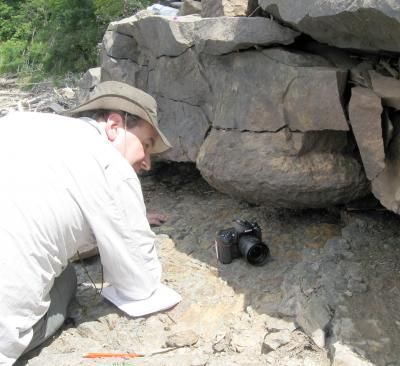
Above: Chris Berry, a paleontologist at Cardiff University, examines the fossilized stump of a Gilboa tree in a quarry at the Gilboa Dam. Photo courtesy of Cardiff University.
Scientists around the world have been waiting for nearly a century to walk among the stumps of the primeval trees of the Gilboa Forest, a group of ancient fossils discovered at the bottom of a quarry near the Gilboa Dam in the 1920s.
At last, the ancient forest floor has been unearthed again, studied, and thoroughly documented. A team of paleontologists from Binghamton University, the New York State Museum and Cardiff University describe what they found there in the prestigious journal Nature today.
At 385 million years old, the Gilboa fossils are the oldest fossils ever found of ancient trees. Work done on the fossil trees in the 1920s by paleontologist Winifred Goldring gave a major boost to scientific knowlege of the Devonian period, when the Schoharie Valley was a coastal wetland teeming with life.
But the quarry the fossils were found in, during the building of the Gilboa Dam, was filled in shortly after it was dug up, and the records originally taken of the fossils' locations were sketchy.
In 2010, the quarry was dug up again as part of a dam maintenance project by the NYC Department of Environmental Protection, giving scientists an opportunity to gain access to the site.
The Times-Union reports today that the team had just two weeks to work before the site was covered up again:
They had to work quickly, since they were invited by officials of the New York City Department of Environmental Protection, which owns the site. The agency was undertaking extensive repairs to the dam, but the construction schedule was tight and the researchers had just two weeks. They worked long days, first mapping the 4,000-square-foot site with a grid and then documenting it with digital photography, field notes, illustrations and specimen gathering.
After two weeks, the world's oldest forest was covered up again with thousands of tons of soil and rock.
At the long-buried quarry floor, the scientists found new species of fosslized trees, and evidence of more complex ecology in the Devonian forest than they had expected. It's a blockbuster discovery for scientists trying to understand the climate and ecology of ancient Earth, a Nature editor writes:
Instead of one kind of tree, they found three, with evidence of spacing and biotic interactions between surprisingly different plant forms. These discoveries should have a major impact on interpreting further fragmentary fossil evidence of these early forests.
A press release from the New York State Museum today describes how the research team were surprised to find fossilized woody plants called aneurophytes at the site:
The aneurophytes are the first in the fossil record to show true “wood” and the oldest known group in the lineage that lead to modern seed plants. Work on the new discoveries also pointed to the vital importance that the State Museum’s collections have played in the paleontological research. “Discovery of scrambling aneurophytaleans at Gilboa was a complete surprise, but pointed to the likelihood that similar material had already been found at the site, but was unrecognized,” said [Linda] Hernick. “Sure enough in the State Museum collections a wonderful specimen, originally collected in the 1920s, provided additional key evidence.”
The team also came across a tree belonging to the class Lycopsida, or club mosses, which predates an earlier discovery made in Naples, NY and an ecologically important group in the history of land plants. The lycopsids are an ancient group of non-seed plants represented today by low growing forms such as the “running pines” of the northern hardwood forests of New York. They also inhabited swamps and ended up being much of the Pennsylvanian coal we burn today.
In another press release today, Berry says the discovery is a career-maker:
"Personally, the chance to walk on that ancient forest floor, and to imagine the plants that I have been studying as fossils for more than 20 years standing alive in the positions marked by their bases, was a career highlight. Seven years ago colleagues Linda and Frank [Hernick and Mannolini, of the New York State Museum] found us a fossil of a complete Gilboa tree. That was amazing. But this time we've got the whole forest!"
Science blog Gizmodo writes that the paleontologists must be "jumping out of their Carhartts" with excitement over the find.
Some of the original Gilboa Fossils are on display at the Gilboa Historical Society on Stryker Road.
Update, 2:50pm: This post has been updated to include several more items that were published this afternoon: the Times-Union story and the material from the New York State Museum.














